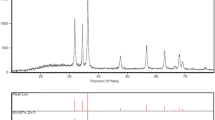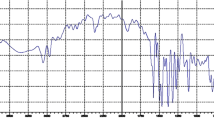Abstract
This work deals with the synthesis of zirconium dioxide (ZrO2) nanoparticles (NPs) in different solvents and their structural characterization for better understanding the oxygen donor solvent/zirconium precursor/NPs structure relationships. By selecting solvents over their capacity to produce different crystalline states from alkalinized zirconium alkoxide, spherical nanoparticles with a size of about 1.3–3 nm and a narrow size distribution were elaborated using a nonaqueous solvothermal sol–gel route. Conventional X-ray diffraction (XRD) was used to determine the average structure and crystallite size of the nanoparticles. Well-crystallized and single-phased nanoparticles with average monoclinic and tetragonal structure were obtained with benzaldehyde and benzyl alcohol, respectively, and a much distorted structure was observed for the synthesis in anisole. The atomic pair distribution functions (PDF) of the samples were also analyzed to access the local structure of the nanoparticles. The PDF of the benzaldehyde-prepared sample is consistent with the monoclinic structure. However, the local structure of nanoparticles synthesized with benzyl alcohol does not fully conform to the tetragonal structure observed by XRD, but exhibits monoclinic-like distortions. Lastly, the anisole-prepared nanoparticles present large structural distortions at the medium range and monoclinic local structural features. The restructuring of this last sample was studied by post-treatments in different solvents and leads to the expression of the tetragonal polymorph. Moreover, it seems that the main structural features are obtained in the early stages of the nanoparticles’ formation.






Similar content being viewed by others
References
Yamaguchi T (1994) Application of ZrO2 as a catalyst and catalyst support. Catal Today 20(2):199–218
Kašpar J, Fornasiero P (2003) Nanostructured materials for advanced automotive de-pollution catalysts. J Solid State Chem 171(1):19–29
Maskell WC (2000) Progress in the development of zirconia gas sensors. Solid State Ion 134(1–2):43–50
Riegel J, Neumann H, Wiedenmann H-M (2002) Exhaust gas sensors for automotive emission control. Solid State Ion 152–153:783–800
Mizutani Y, Hisada K, Ukai K, Sumi H, Yokoyama M, Nakamura Y, Yamamoto O (2006) From rare earth doped zirconia to 1 kW solid oxide fuel cell system. J Alloys Compd 408–412(9):518–524
Ralph JM, Schoeler AC, Krumpelt M (2001) Materials for lower temperature solid oxide fuel cells. J Mater Sci 36(5):1161–1172. https://doi.org/10.1023/A:1004881825710
Bocanegra-Bernal MH, Diaz de la Torre S (2002) Phase transitions in zirconium dioxide and related materials for high performance engineering ceramics. J Mater Sci 37(33):4947–4971. https://doi.org/10.1023/A:1021099308957
Garvie RC, Goss MF (1986) Intrinsic size dependence of the phase transformation temperature in zirconia microcrystals. J Mater Sci 21(4):1253–1257. https://doi.org/10.1007/BF00553259
Brus LE (1984) Electron–electron and electron-hole interactions in small semiconductor crystallites: the size dependence of the lowest excited electronic state. J Chem Phys 80(9):4403–4409
Lippens PE, Lannoo M (1989) Calculation of the band gap for small CdS and ZnS crystallites. Phys Rev B 39(15):10935–10942
Alivisatos AP (1996) Semiconductor clusters, nanocrystals, and quantum dots. Science 271(5251):933–937
Dosch H (2001) Some general aspects of confinement in nanomaterials. Appl Surf Sci 182(3–4):192–195
Gilbert B, Huang F, Zhang H, Waychunas GA, Banfield JF (2004) Nanoparticles: strained and Stiff. Science 305(5684):651–654
Egami T, Billinge SJ (2003) Underneath the Bragg peaks: structural analysis of complex materials. Elsevier Ltd, Oxford
Cheema TA, Garnweitner G (2014) Phase-controlled synthesis of ZrO2 nanoparticles for highly transparent dielectric thin films. Cryst Eng Commun 16:3366–3375
Arnal P, Corriu RJP, Leclercq D, Mutin PH, Vioux A (1996) Preparation of anatase, brookite and rutile at low temperature by non-hydrolytic sol–gel methods. J Mater Chem 6(12):1925–1932
Garnweitner G (2005) Thesis: nonaqueous synthesis of transition-metal oxide nanoparticles and their formation mechanism
Garnweitner G, Goldenberg L, Sakhno O, Antonietti M, Niederberger M, Stumpe J (2007) Large-scale synthesis of organophilic zirconia nanoparticles and their application in organic–inorganic nanocomposites for efficient volume holography. Small 3(9):1626–1632
Cimino A, Gazzoli D, Minelli G, Valigi M (1992) Effect of Na+ ions on some properties of hydrous and thermally decomposed zirconium oxide. J Mater Chem 2:75–82
Adamski A, Jakubus P, Sojka Z (2006) Synthesis of nanostructured tetragonal ZrO2 of enhanced thermal stability. Nukleonika 51(1):27–33
De Keukeleere K, Roo JDLP, Martins JC, Voort PVD, Driessche IV (2015) Fast and Tunable Synthesis of ZrO2 Nanocrystals: mechanistic Insights into Precursor Dependence. Inorg Chem 54(7):3469–3476
Vioux A, Mutin PH (2009) Nonhydrolytic processing of oxide-based materials: simple routes to control homogeneity, morphology, and nanostructure. Chem Mater 21(4):582–596
Pinna N, Karmaoui M, Willinge MG (2011) The “benzyl alcohol route”: an elegant approach towards doped and multimetal oxide nanocrystals, short review and ZnAl2O4 nanostructures by oriented attachment. J Sol Gel Sci Technol 57:323–329
Anandan K, Rajesh K, Rajendran V (2017) Enhanced optical properties of spherical zirconia (ZrO2) nanoparticles synthesized via the facile various solvents mediated solvothermal process. J Mater Sci Mater Electron 28(22):17321–17330
Wongmaneenil P, Jongsomjit B, Praserthdam P (2010) Study on solvent/alkoxide molar ratios on synthesis zirconia nanoparticles for tungstated zirconia catalysts over esterification. Catal Lett 139:42–49
Park JY, Rama Raju GS, Moon BK, Jeong JH (2015) Facile solvothermal synthesis of high refractive index ZrO2 spheres: estimation of the enhanced light extraction efficiency. RSC Adv 5:81915–81919
Gambe J, Remondiere F, Jouin J, Portal L, Thomas P, Masson O (2019) Detrimental effect and neutralization of in situ produced water on zirconia nanoparticles obtained by a nonaqueous sol-gel method Inorg Chem (in press)
Rodriguez-Carvajal J, Roisnel T (2003) Computer program FULLPROF (LLB-LCSIM)
Young RA (1993) The rietveld method. Oxford University Press, Oxford
Masson O (2012) pyTSRedX, a data reduction computer program to obtain the atomic pair distribution function (PDF) from X-ray total scattering data
Masson O (2008) XTSScan: X ray total scattering acquisition program
Grena R, Masson O, Portal L, Remondiere F, Berghout A, Jouin J, Thomas P (2015) The effect of surface impurities on the structure of ultrasmall ZrO2 nanoparticles: an ab initio study. J Phys Chem C 119(27):15618–15626
Teufer G (1962) The crystal structure of tetragonal ZrO2. Acta Cryst A 15(11):1187
Howard CJ, Hill RJ, Reichert BE (1988) Structures of ZrO2 polymorphs at room temperature by high-resolution neutron powder diffraction. Acta Crystallogr B 44(2):116–120
Garvie RC (1965) The occurrence of metastable tetragonal zirconia as a crystallite size effect. J Phys Chem 69(4):1238–1243
Garvie RC (1978) Stabilization of the tetragonal structure in zirconia microcrystals. J Phys Chem 82(2):218–224
Dippel A-C, Jensen KMO, Tyrsted C, Bremholm M, Bojesen ED, Saha D, Birgisson S, Christensen M, Billinge SJL, Iversen BB (2016) Towards atomistic understanding of polymorphism in the solvothermal synthesis of ZrO2 nanoparticles. Acta Cryst A 72:645–650
Acknowledgements
This work was supported by Région Limousin. The authors are grateful to P. Carles and R. Mayet of the University of Limoges for TEM and XRD measurements.
Author information
Authors and Affiliations
Corresponding author
Additional information
Publisher's Note
Springer Nature remains neutral with regard to jurisdictional claims in published maps and institutional affiliations.
Rights and permissions
About this article
Cite this article
Gambe, J., Jouin, J., Remondiere, F. et al. Solvent effect in the nonaqueous synthesis of ZrO2 nanoparticles under alkaline conditions. J Mater Sci 55, 2802–2814 (2020). https://doi.org/10.1007/s10853-019-04137-9
Received:
Accepted:
Published:
Issue Date:
DOI: https://doi.org/10.1007/s10853-019-04137-9




